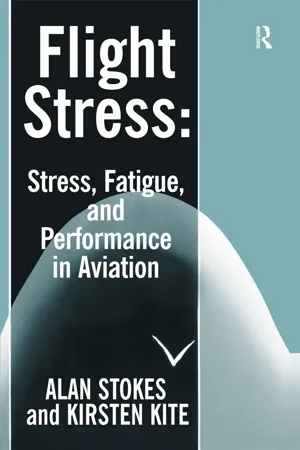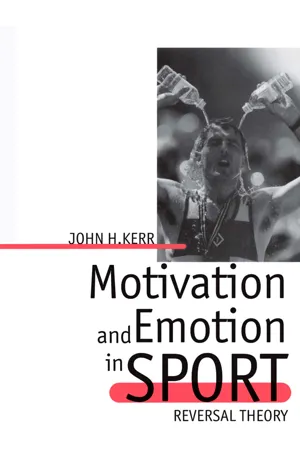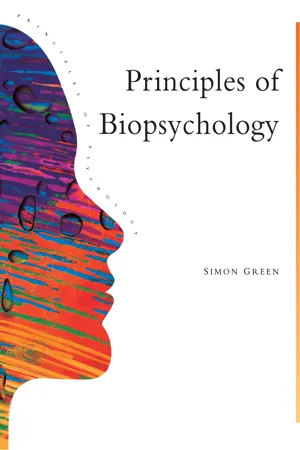Psychology
Optimal Arousal Theory
Optimal Arousal Theory suggests that individuals seek an optimal level of arousal or stimulation to perform at their best. This theory proposes that people are motivated to maintain an ideal level of arousal, with performance being best when arousal is moderate. It implies that individuals may seek out activities or environments that provide the level of stimulation they desire.
Written by Perlego with AI-assistance
Related key terms
5 Key excerpts on "Optimal Arousal Theory"
- eBook - ePub
Flight Stress
Stress, Fatigue and Performance in Aviation
- Alan F. Stokes, Kirsten Kite(Authors)
- 2017(Publication Date)
- Routledge(Publisher)
This assumption alone could be queried on a number of levels. For example, one of the implications of Apter’s intuitively plausible model, discussed earlier, is that there is not one optimum arousal level but two, one for each motivational state. 1 However, as Jones 12 points out, there is a much more fundamental problem with the optimal arousal concept: As with other approaches embodying an optimum, the difficulty of circularity has yet to be countered. This means that the optimum can be specified only post hoc. The problem of the optimum is further complicated by the dynamic nature of the stress response, that is, not only do models of stress need to specify the optimum in advance, they also need to account in advance for changes in the optimum, (p. 73) Ironically, despite the associated difficulties, it is probably the very notion of an optimum which has had so much appeal as to lead to the overgeneralization of the original Yerkes-Dodson findings. Noted British stress researcher Robert Hockey suggests that this probably occurred because the ‘inverted U’ relationship between performance and arousal (or, with a little conceptual slippage, stress) is intuitively satisfying. 10 It is, after all, a matter of common sense that optimal performance will neither be associated with extreme lethargy nor with highly emotional states. Similarly, it feels intuitively appropriate that anxiety and nervousness will tend to have a stronger adverse effect on the performance of difficult tasks than of comparatively simple ones - eBook - ePub
Motivation and Emotion in Sport
Reversal Theory
- John H. Kerr(Author)
- 2014(Publication Date)
- Psychology Press(Publisher)
This is an opportune place to compare some of the main aspects of the rival approaches just mentioned with reversal theory. As Optimal Arousal Theory (e.g. Fiske & Maddi, 1961; Hebb, 1955; Hebb & Thompson, 1954) and its forerunner, the inverted-U hypothesis (Yerkes & Dodson, 1908), have played a major role in sport psychology over the past 25 years (e.g. Klavora, 1977; Martens & Landers, 1970; Sonstroem & Bernardo, 1982), it seems appropriate to begin the comparison with them.Comparing Optimal Arousal Theory and Reversal TheoryThe main concepts of reversal theory have been set out in Chapter 2 and elaborated on in each of the chapters that follow. However, a brief description of Optimal Arousal Theory (Fiske & Maddi, 1961; Hebb, 1955; Hebb & Thompson, 1954) is necessary before the two theories can be contrasted. Yerkes and Dodson’s (1908) experimental work with rats was concerned with motivation and task complexity. They found that a graph representing the relationship between motivation and performance followed an inverted-U shape and that the peak of the inverted-U curve shifted as a function of task difficulty. Later, this relationship was incorporated into Optimal Arousal Theory (Hebb, 1955), in which the importance of the optimal level of arousal was brought to the fore. Optimal Arousal Theory argued that increases in arousal were beneficial to performance up to a certain point, beyond which any further increases in arousal would lead to a decrease in the level of performance. This hypothesised relationship between arousal and performance, represented by the well known inverted-U-shaped graph, has often featured in explanations of sports performance.Some researchers have carried out sport-based empirical studies in motor steadiness (Martens & Landers, 1970), high-school basketball (Klavora, 1977) and university basketball (Sonstroem & Bernardo, 1982) in which they purported to find an inverted-U relationship between arousal and performance. Sonstroem and Bernardo (1982), for example, studied the state anxiety scores of 30 female university basketball starters from six teams in relation to their performance scores. (State anxiety is subjective, consciously perceived feelings of apprehension and tension, accompanied by or associated with activation or arousal; Spielberger, 1966.) Composite performance scores were used, which took into account aspects of game performance such as success in shooting, rebounds, assists, turnovers, and fouls. Sonstroem and Bernardo (1982) argued that their results, which showed that high state anxiety scores were associated with the poorest performances, supported the inverted-U hypothesis. - eBook - ePub
Motivation
Biological, Psychological, and Environmental
- Lambert Deckers(Author)
- 2022(Publication Date)
- Routledge(Publisher)
According to the zone of optimal functioning hypothesis, each individual has her preferred zone of arousal based on cognitive and somatic anxiety. Athletic performance is better within the zone and worse below and above it. Time of day determines arousal when people feel their best and individuals vary widely when they do so. Morning-type individuals feel their best closer to 9 a.m. and evening-type individuals feel their best closer to 9 p.m. THEORIES ABOUT THE PERFORMANCE–AROUSAL RELATIONSHIP How can we explain the inverted-U arousal–performance relationship? There are several proposals: the cusp catastrophe model Model from sports psychology indicating that performance depends jointly on cognitive arousal and on physiological arousal (somatic anxiety). in sports psychology, processing efficiency theory Performance on a cognitive task depends on working memory. Efficiency declines when worry takes up the working memory space that is needed to perform the task., and attentional control theory Anxiety and worry weaken a person's ability to inhibit paying attention to extraneous stimuli and responses that are irrelevant to the goal at hand.. How well does each theory explain the effects of arousal on behavior? Cusp Catastrophe Model Sport is one of those endeavors in which it is very important to control arousal in order to maximize performance. Arousal factors that determine athletic performance are addressed in the cusp catastrophe model from sports psychology. This model uses two types of arousal: cognitive anxiety and physiological or body arousal (somatic anxiety) (Hardy, 1996a, 1996b). At low physiological arousal, increases in cognitive anxiety produce a slight improvement in athletic performance, while at high physiological arousal, increases in cognitive anxiety produce a decline in performance - eBook - ePub
Human Performance
Cognition, Stress and Individual Differences
- D. Roy Davies, Gerald Matthews, Rob B. Stammers, Steve J. Westerman(Authors)
- 2013(Publication Date)
- Psychology Press(Publisher)
optimal level of arousal for performance. Second, the optimal level of arousal for performance is inversely related to task difficulty. The more difficult the task, the lower the ideal arousal level for performance. It may be assumed that stress influences arousal, which in turn influences performance. Stress-inducing agents, or stressors, which raise arousal may then be grouped together as having similar effects. Commonly-used arousing agents include noise, incentive and stimulant drugs such as nicotine and caffeine. Although performing under incentive, for example, is not necessarily unpleasant or “stressful”, it is conventional to refer to all such influences as stressors. Similarly, dearousing stressors such as sleep deprivation and sedative drugs should have similar effects on performance.9.3.1 Developing arousal theory: Methods and explanations
The simplicity of the Yerkes-Dodson Law belies a chequered history. In its original form, it concerned motivation (“drive”) rather than arousal per se. Yerkes and Dodson (1908) demonstrated inverted-U relationships between strength of electric shock (a motivating factor) and speed of learning. In more recent times, the continuum of electrocortical states apparent in the EEG was seenFIG. 9.3 The inverted-U hypothesis (Yerkes-Dodson Law).as the primary expression of arousal (e.g. Duffy, 1962). Subsequently, however, many performance psychologists became disillusioned by difficulties in measuring arousal reliably and validly using psychophysiological techniques, and sought a purely behavioural definition of arousal. - eBook - ePub
- Simon Greene(Author)
- 2013(Publication Date)
- Psychology Press(Publisher)
8 Sleep, Arousal, and Biological Rhythms The Concept of ArousalWe have already met “arousal” in the last chapter, in the shape of the peripheral physiological activation produced by arousing and stressful stimuli. Unfortunately this is not the only way in which the term is used in psychology and biopsychology.“Arousal” sounds as if it should always have a grounding in physiological processes. However, psychologists have more often used it as an explanatory concept which is defined operationally. This means that instead of talking about activity in the adrenal medulla or in sympathetic neurons, the psychologist refers to certain behavioural manipulations, or “operations”, which are assumed to have an “arousing” effect. For instance, giving a rat mild electrical footshocks, presenting human subjects with sudden bursts of loud noise, or telling subjects that the better they perform a task the greater will be their rewards (“incentive”), are all assumed to be arousing manipulations. If they have systematic effects on behaviour, then these effects can be explained by a hypothetical concept of “arousal”. The psychologist does not have to specify the precise physiological actions of his or her manipulations, although it would, of course, strengthen the argument if the hypothesised arousal could be related to physiological processes.The first and most influential statements on the role of arousal in behaviour were put forward by Yerkes and Dodson (1908). They investigated the effects of electric footshock on the ability of rats to perform tasks in which they had to discriminate lights of different brightnesses.“Arousal” was varied by changing the intensity of the footshock. From the results of these and other studies, Yerkes and Dodson put forward two propositions, the first of which has become known as the Yerkes-Dodson law:
Learn about this page
Index pages curate the most relevant extracts from our library of academic textbooks. They’ve been created using an in-house natural language model (NLM), each adding context and meaning to key research topics.




